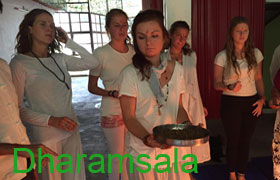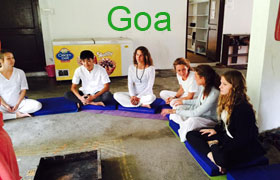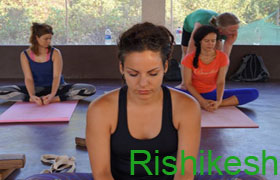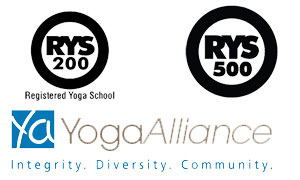Pranavayu:
वृद्धि प्राणो वहेन्नित्यं – prana, the soul is located in the heart
अपानोगुदामंडले – apaana is located in the anal area
समानाभिदेशेतु – saman is located in the navel
उदानकंठमाध्यतः – Udan is located in the throat region
वयानों व्यपयो शरीरे – vyan is spread throughout the body
The above mentioned five vayus are the most significant and are called prana vayu. The other five namely naaga, karma, kukala, devadatta, dahnanjay are called uppranaa vayu.
उद्गारे नाग आख्यातः – the act of belching is handled by naaga vayu
कूर्मस्तुन्मीलने स्मृतः – closing and opening your eyes is handled by kurma vayu
कुकलः क्षुत्कृते ज्ञेयो – sneezing is handled by kukula vayu
देवदत्तो विजृम्भणे – the act of yawning happens due to devadatta vayu
न जहातिमृतेक्वापि सर्वव्यापी धनंजय –
dhananjay vayu helps in maintaining the temperature of the body after the death.
You may notice that every upaprana vayu is related to one prana vayu. Likewise naaga vayu is related to samaan vayu, kurma vayu is related to udaan vayu, kukala is related to prana vayu and dhananjay vayu is related vyan vayu.
Anulom Vilom Pranayama
Procedure
Sit in any meditative posture. Fold your index and middle fingers and leave the remaining finger straight and make pranayama mudra with your palm. Close your right nostril with the thumb of your right hand and inhale air through your left nostril. Now release your right nostril, close your left nostril and exhale the air that was inhaled earlier. Now without any lapse you should inhale air with your right nostril keeping your left nostril closed. Then release your left nostril, close your right nostril and exhale the air that is just inhaled. All these steps constitute one chakra or cycle. You can practice 20 to 50 cycles of repetitions of it in the morning and in the evening. It is highly important to practice anulom vilom pranayama prior to the practice of nadi shodhana pranayama.
Benefits
1. This process oxygenates the whole body.
2. Improves the mental peace.
3. The efficiencies of respiratory system and circulatory system are improved.
4. It is highly beneficial for your heart and lungs.
5. It is very useful for high blood pressure.
Nadi Shodhana Pranayama
After the practice of anulom and vilom pranayama you should practice nadi shodhana pranayama. If a seeker attempts to practice nadi shodhana pranayama without practicing anulom and vilom pranayama he may have to face complications such as physical and mental disorders. Nadi shodhan pranayama is divided into five different parts.
1. 1 : 1 : 2
2. 1 : 2 : 2
3. 1 : 3 : 2
4. 1 : 4 : 2
5. 1 : 4 : 2 : 1
1. 1 : 1 : 2
This means the time for which the air is locked inside should be equal to the time taken for inhaling that air. Trying to lock the air inside through the practice of tribandh is called the anthah kumbhak. Thus the time taken to exhale the air should be twice that of anthah kumbhak.
Procedure
Sit in any meditational posture. Close your right nostril with the thumb of your right hand in pranayama mudra. Now if you inhale air with your left nostril for 5 seconds you should also lock the air inside through the practice of tribandha for 5 seconds. Then release your right nostril and you should exhale locked air through it for 10 seconds. Now without any lapse, inhale through your right nostril for 5 seconds and lock the air for 5 seconds through the practice of tribandha again. Now exhale the locked air through your left nostril for 10 seconds. This process constitutes for one cycle or chakra. A beginner can practice 10 to 15 cycles of this process. This is the first part of nadi shodhana pranayama and can be practiced by anyone. But smokers and drunkards should not attempt to practice the further parts of nadi shodhana pranayama. They are allowed to practice only the first part of it. The seeker should be a pure vegetarian in order to practice the remaining parts of nadi shodhana pranayama. He can also practice the last part involving bahya kumbhak. In this part 1-4-2-1 indicates that if you inhale air in through the left nostril for 5 seconds, you should lock the air inside for 20 seconds. Then exhale this locked air through your right nostril for 10 seconds and pause for 5 seconds without breathing. Now you should inhale the air through your right nostril for 5 seconds, you should lock the air inside for 20 seconds. Then exhale this locked air through your left nostril for 10 seconds and pause for 5 seconds without breathing again. This constitute one cycle. You can repeat this for any number of cycles as per your stamina.
The yoga seeker should never try to make attempt to jump to fifth part directly from the first part. The practice should be gradually increased consistently. When you have advanced to a good level of practice you can directly go ahead with fourth or fifth part. This nadi shodhana paranayaam is incomplete without the yoga sadhana. This is the most important type of pranayama.
Benefits
1. It cuts off the excess weight.
2. It can eliminate every kind of physical and mental disorder.
3. It purifies all the nerves of the body and makes the body healthy, beautiful and brilliant.
4. It can alleviate all kinds of problems related to joints.
5. It can eliminate all the negative thoughts and provoke positive thoughts. Therefore it can make your life blissful and adventurous.
6. It improves the functionality of our blood circulation system and clears away any blockages pertaining to the functioning of your heart.
7. Nadi shodhana pranayama is the best way that can aid the awakening of kundalini shakti.
Our yoga teacher training in India is known throughout the world for perfect training provided for pranayama.





